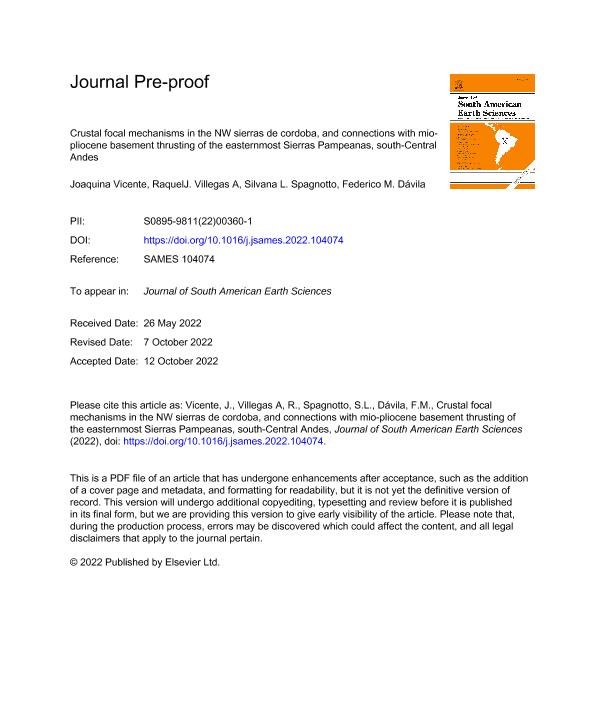Mostrar el registro sencillo del ítem
dc.contributor.author
Vicente, Joaquina

dc.contributor.author
Villegas Alvarez, Raquel Judith

dc.contributor.author
Spagnotto, Silvana Liz

dc.contributor.author
Davila, Federico Miguel

dc.date.available
2023-08-03T12:35:40Z
dc.date.issued
2022-10
dc.identifier.citation
Vicente, Joaquina; Villegas Alvarez, Raquel Judith; Spagnotto, Silvana Liz; Davila, Federico Miguel; Crustal focal mechanisms in the NW sierras de Córdoba, and connections with mio-pliocene basement thrusting of the easternmost Sierras Pampeanas, south-Central Andes; Pergamon-Elsevier Science Ltd; Journal of South American Earth Sciences; 120; 104074; 10-2022; 1-14
dc.identifier.issn
0895-9811
dc.identifier.uri
http://hdl.handle.net/11336/206728
dc.description.abstract
The seismicity studied in this paper is located along the back arc region, between 30°35′ and 31°52’ S latitude, in the morphostructural unit known as Eastern Sierras Pampeanas. Seventeen crustal earthquakes could be identified and located, between June 2004 and March 2018, using seismic data recorded by the broadband seismological network of National Institute for Seismic Prevention (INPRES), combined with free seismic data from the Incorporated Research Institutions for Seismology (IRIS). Focal mechanisms were calculated from localized seismicity using the P-wave first motions and interpreted as a strain style on the western portion of Sierras de Córdoba. Overall, the seismicity in this region during the study period was constrained to the upper ∼25 km of the crust and is mostly concentrated along minor structures and not along the major range-bounding faults. Although there is evidence of quaternary activity along the larger structures, the relationship between these displacements and modern deformations is not well developed due to the lack of local seismic stations in the area and the long recurrence interval between earthquakes of significant magnitudes. However, very recent morphometric studies in the Sierras Pampeanas have analyzed the main topography controls and suggested relatively higher uplift rates in the central sectors of the Sierra de Pocho, and a balance between tectonic uplift and erosion rates. Nevertheless, three seismic events showed greater depths around 36 km according to previously proposed geological and geophysical models of crustal thickness and mohorovicic depth. Although focal mechanism solutions show varied results, distributed throughout all the region, it is possible to determine an inverse deformation with an oblique component assigned to regional faults and an area where a normal deformation with an oblique component predominates, near to the Ojo de Agua Lineament. Accordingly with seismological observations, we proposed a model in which the seismogenic structures seem to have detached from deep horizontal intra-crustal interfaces that affects the faults and brittle structures, which document that the Eastern Sierras Pampeanas are actively deforming in response to compression from the convergent margin.
dc.format
application/pdf
dc.language.iso
eng
dc.publisher
Pergamon-Elsevier Science Ltd

dc.rights
info:eu-repo/semantics/openAccess
dc.rights.uri
https://creativecommons.org/licenses/by-nc-nd/2.5/ar/
dc.subject
Sismología
dc.subject
Tectónica frágil
dc.subject
Sierras Pampeanas
dc.subject
Subducción plana
dc.subject.classification
Geoquímica y Geofísica

dc.subject.classification
Ciencias de la Tierra y relacionadas con el Medio Ambiente

dc.subject.classification
CIENCIAS NATURALES Y EXACTAS

dc.title
Crustal focal mechanisms in the NW sierras de Córdoba, and connections with mio-pliocene basement thrusting of the easternmost Sierras Pampeanas, south-Central Andes
dc.type
info:eu-repo/semantics/article
dc.type
info:ar-repo/semantics/artículo
dc.type
info:eu-repo/semantics/publishedVersion
dc.date.updated
2023-07-07T17:23:04Z
dc.journal.volume
120
dc.journal.number
104074
dc.journal.pagination
1-14
dc.journal.pais
Países Bajos

dc.journal.ciudad
Amsterdam
dc.description.fil
Fil: Vicente, Joaquina. Consejo Nacional de Investigaciones Científicas y Técnicas. Centro Científico Tecnológico Conicet - Córdoba. Centro de Investigaciones en Ciencias de la Tierra. Universidad Nacional de Córdoba. Facultad de Ciencias Exactas Físicas y Naturales. Centro de Investigaciones en Ciencias de la Tierra; Argentina
dc.description.fil
Fil: Villegas Alvarez, Raquel Judith. Consejo Nacional de Investigaciones Científicas y Técnicas. Centro Científico Tecnológico Conicet - San Juan; Argentina. Universidad Nacional de San Juan. Facultad de Ciencias Exactas, Físicas y Naturales. Instituto Geofísico Sismológico Volponi; Argentina
dc.description.fil
Fil: Spagnotto, Silvana Liz. Consejo Nacional de Investigaciones Científicas y Técnicas. Centro Científico Tecnológico Conicet - San Luis; Argentina. Universidad Nacional de San Luis; Argentina. Universidad de Buenos Aires; Argentina
dc.description.fil
Fil: Davila, Federico Miguel. Consejo Nacional de Investigaciones Científicas y Técnicas. Centro Científico Tecnológico Conicet - Córdoba. Centro de Investigaciones en Ciencias de la Tierra. Universidad Nacional de Córdoba. Facultad de Ciencias Exactas Físicas y Naturales. Centro de Investigaciones en Ciencias de la Tierra; Argentina
dc.journal.title
Journal of South American Earth Sciences

dc.relation.alternativeid
info:eu-repo/semantics/altIdentifier/url/https://www.sciencedirect.com/science/article/pii/S0895981122003601
dc.relation.alternativeid
info:eu-repo/semantics/altIdentifier/doi/https://doi.org/10.1016/j.jsames.2022.104074
Archivos asociados
